Who Is Morgan Rogers?
Back in April 2023, Millwall’s Zian Flemming dispatched a penalty condemning Blackpool to relegation to England’s third tier.
In the Tangerine’s starting XI that day was then-Manchester City loanee and attacking midfielder, Morgan Rogers.
Fast forward to the present day, Rogers is a recently established regular in Unai Emery’s Aston Villa side, who are ready to embark on Champions League football this campaign.
It is an outstanding rise up the football pyramid for the 21-year-old in such a short period of time.
Rogers’ time at Blackpool had shown signs of promise, but overall, it was somewhat underwhelming.
The former West Brom academy graduate scored only once in 20 appearances for the then-championship club.
Rogers’ raw talent, though, was enough to persuade Middlesbrough to acquire his services from City for a fee believed to be in the region of £1 million.
Billed as one for the future on Teesside, it was a surprise to many that Rogers departed for high-flying Aston Villa in January 2024, only six months into his Boro deal.
While some believed that Rogers was not ready to step up to the rigours of Premier League football, the midfielder is currently proving any doubters wrong as he became a regular in the Midlands at the tail end of last season.
In this tactical analysis and Morgan Rodgers scout report, we will highlight Rogers’s development over the last year and further delve into how Rogers has slotted into different tactics, enabling the midfielder to progress his game.
Morgan Rogers Style Of Play
Middlesbrough’s recent transfer policy has been to invest in young potential, developing such players in the hope of generating a profit later on.
Boro identified Rogers as a player who fit this remit following his loan spell at Blackpool.
Morgan Rogers Radar Map
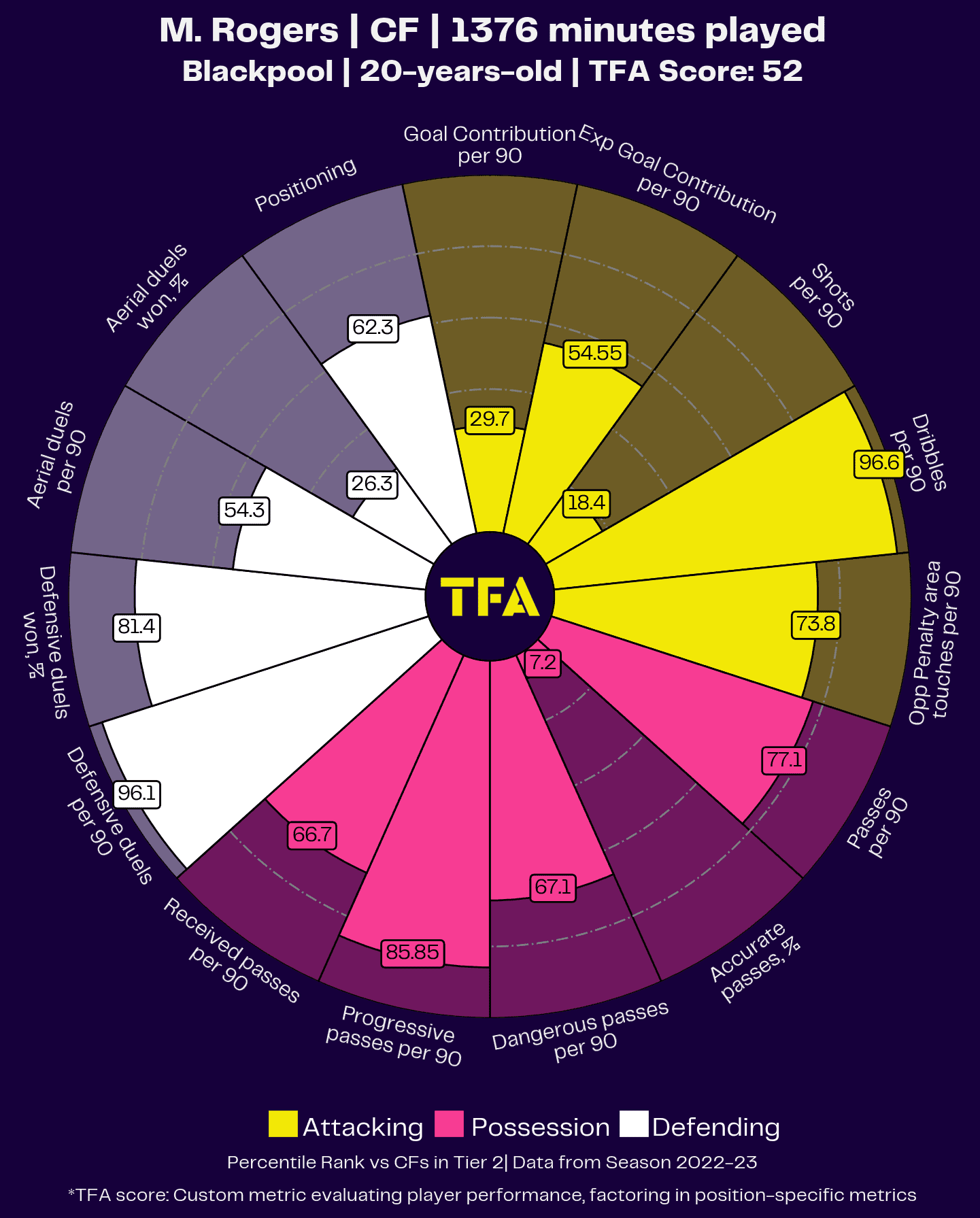
The pizza plot shows that despite featuring for a struggling side in the Championship prior to his Boro move, Rogers ranked highly compared to his peers for his positive play when in possession.
Moreover, Rogers ranked highly for his dribbling ability and would not shirk his defensive work, as he ranked in the top 20% for percentage of defensive duels won.
However, the midfielder’s game had flaws.
As shown in the previous graphic, Rogers had much to improve on in terms of keeping possession for his side and producing end product in front of goal.
Rogers arrived on Teesside just as Middlesbrough was nursing a hangover following defeat in the playoffs.
Michael Carrick’s side had also just lost loanees Cameron Archer and Aaron Ramsey as well as top goalscorer Chuba Akpom, who had departed for Ajax.
Therefore, the attacking midfielder had big shoes to fill, and it was a lot of pressure to put on the then-20-year-old.
Rogers typically played on the left or centrally of the advanced midfielders in Boro’s 4-2-3-1 system.
However, due to slow progress in the transfer market coupled with injuries, it was not uncommon for Rogers to lead the line.
This role was unfamiliar for Rogers, though, as he lacked the strength to hold up play.
Although he has pace, he wasn’t quick enough to make runs in behind defenders.
Rogers prefers to be involved in the play and use his neat footwork to create openings, as he is comfortable with either his left or right foot.
In theory, Rogers was ideal for Carrick’s preferred attacking principles—patient build-up play looking to make intelligent passes in tight areas in the final third.
It was evident from the outset that Rogers was keen to make an impression in his new side, but the former Manchester City player often wanted too much time on the ball.
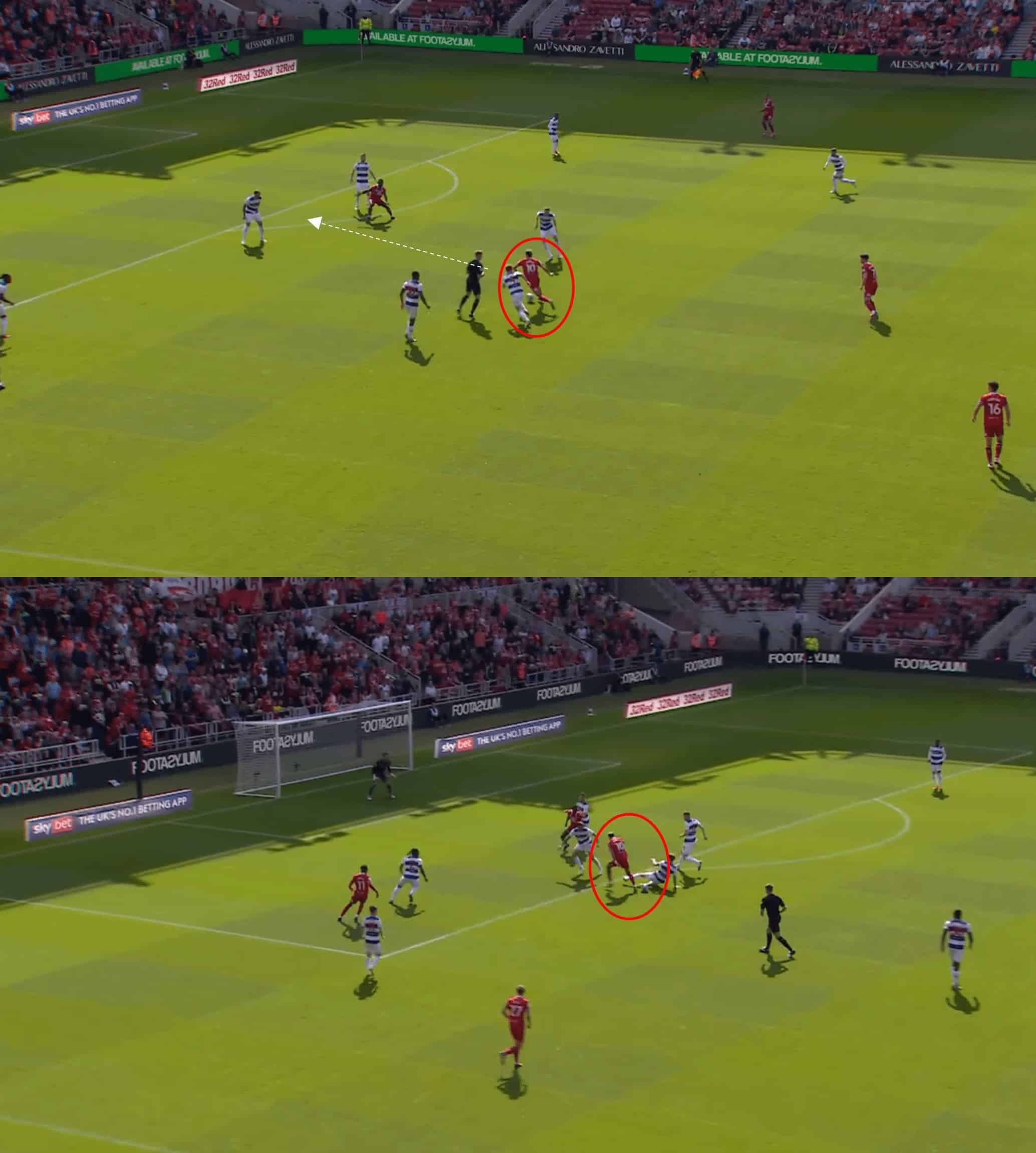
This was exactly the case in the above example, where Rogers had the intelligence to turn away from the opposition and drive forward.
However, upon creating the space, Rogers should have opted for a through pass toward the forward Emmanuel Latte Lath but instead kept possession, only to be dispossessed.
It proved to be a common theme in his early Middlesbrough career as the young midfielder was dispossessed 2.48 times per 90 and recorded 3.45 miscontrols per 90 throughout his time at the Riverside.
Middlesbrough started last season in poor form, with their only two victories in their opening eight fixtures in all competitions coming in the League Cup.
During this time, Rogers had an expected goals tally of just 1.22, exemplifying the little impact he made on the Teessiders’ goal threat.
Carrick’s side only averaged 1.25 goals per game in these opening eight fixtures despite often dominating possession.
Whilst it would be unfair to shoulder the disappointing attacking statistics during this time solely down to Rogers, the former Manchester City man was unable to make a significant impact at his new club.
He soon found himself resigned to the bench thereafter.
Morgan Rogers Progressing In The North-East
Rogers had shown flashes of potential upon his move to the North East, but honing that talent on the training ground was required, and work was done to help the midfielder improve his decision-making.
Rogers has been vocal in the past about his eagerness to learn the tactical and analytical side of the game.
He was able to develop an understanding of Middlesbrough’s style of play when amongst the substitutes.
It is no easy feat to make an impact from the bench, as players need to adjust to the pace of the match, but Rogers was able to make an impression in games in such scenarios in early October last season.
He notably contributed an assist in victory at Sunderland and scored a late winner against Birmingham City following introductions from the bench.
The graphic below highlights how Rogers made an impact against the Blues.
He found space and influenced the match in positions that Boro had occupied less frequently prior to Rogers’ introduction.
Morgan Rogers Heat Map
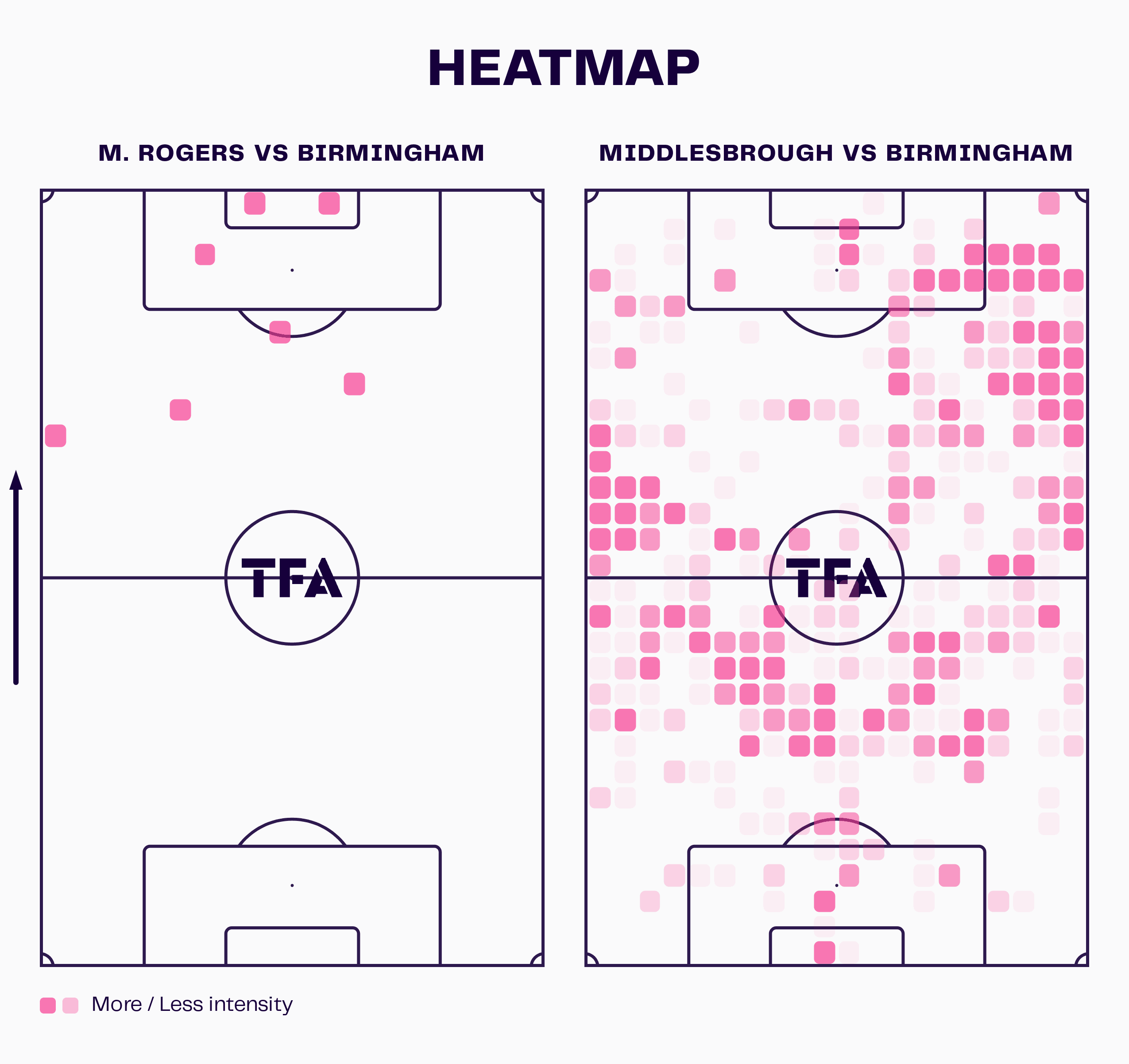
Although Boro dominated possession against the Blues, the heatmap shows that they had much more play in the attacking third down the right flank.
However, upon his introduction to the match, Rogers was able to provide a threat both centrally and on the left side in the final third and, hence, provide Middlesbrough with a different attacking outlet.
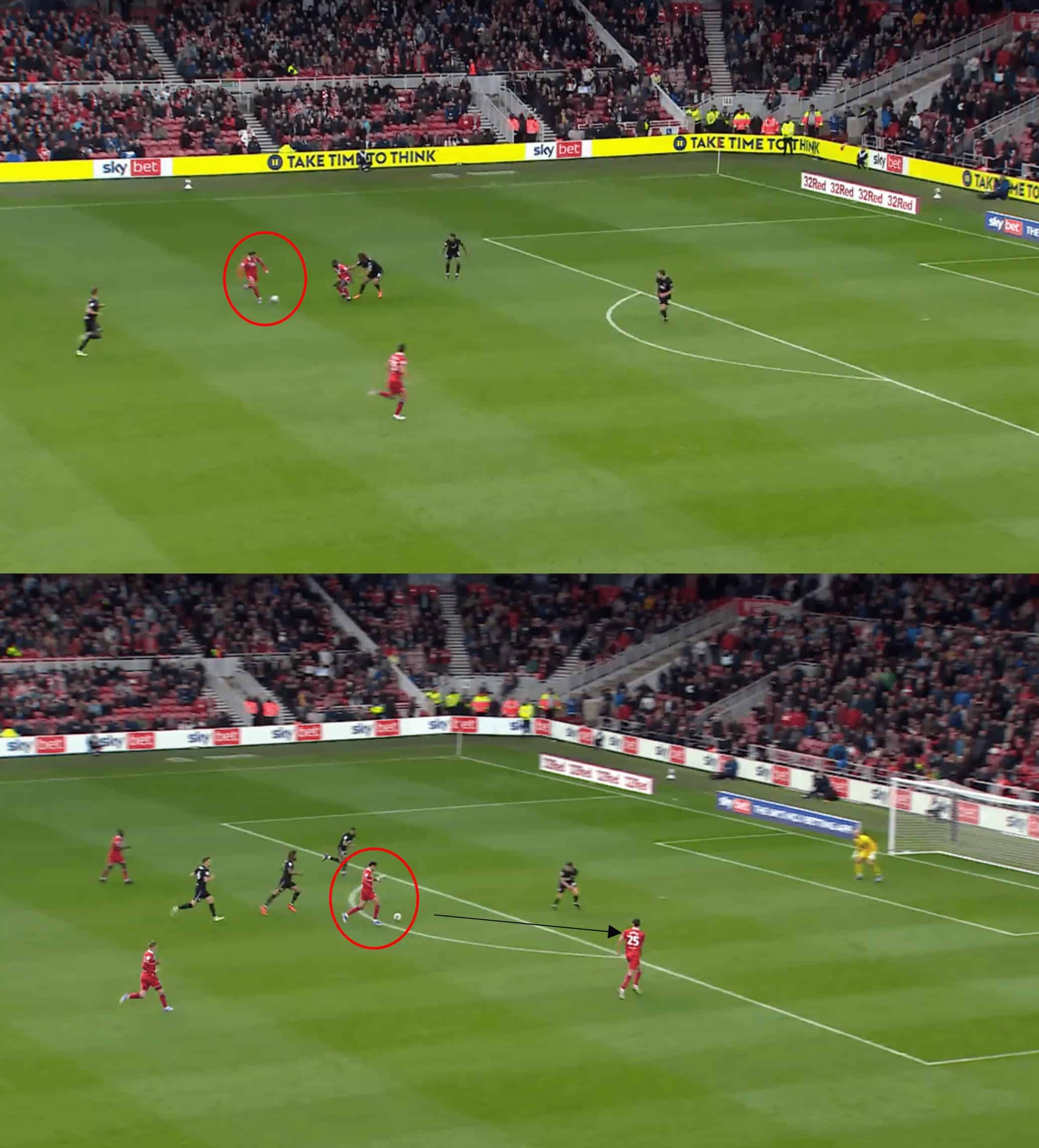
As Middlesbrough piled forward on the counter against Birmingham, Rogers was free on the left side to pick up the loose ball and drive forward.
He then played a pass out to Matt Crooks on the right.
Although the pass itself was not the most accurate, Crooks was able to supply a cross, which Rogers met just before the goalkeeper to give his side the lead.
Another takeaway from this example, as well as Rogers’ positioning, is his unselfish play.
In the early days of his Middlesbrough career, Rogers would likely have opted for an attempt at goal on the edge of the penalty area.
However, he was showing signs of growing into his role in playing with his unmarked teammate.
The evidence pointed to a player who was starting to value the team rather than go for individual brilliance.
As last season progressed, Rogers found himself back in the starting XI and found a rich vein of form around the festive period, with two goals and three assists in five matches.
The attacking midfielder started to link up play with his Boro counterparts with intelligent passing.
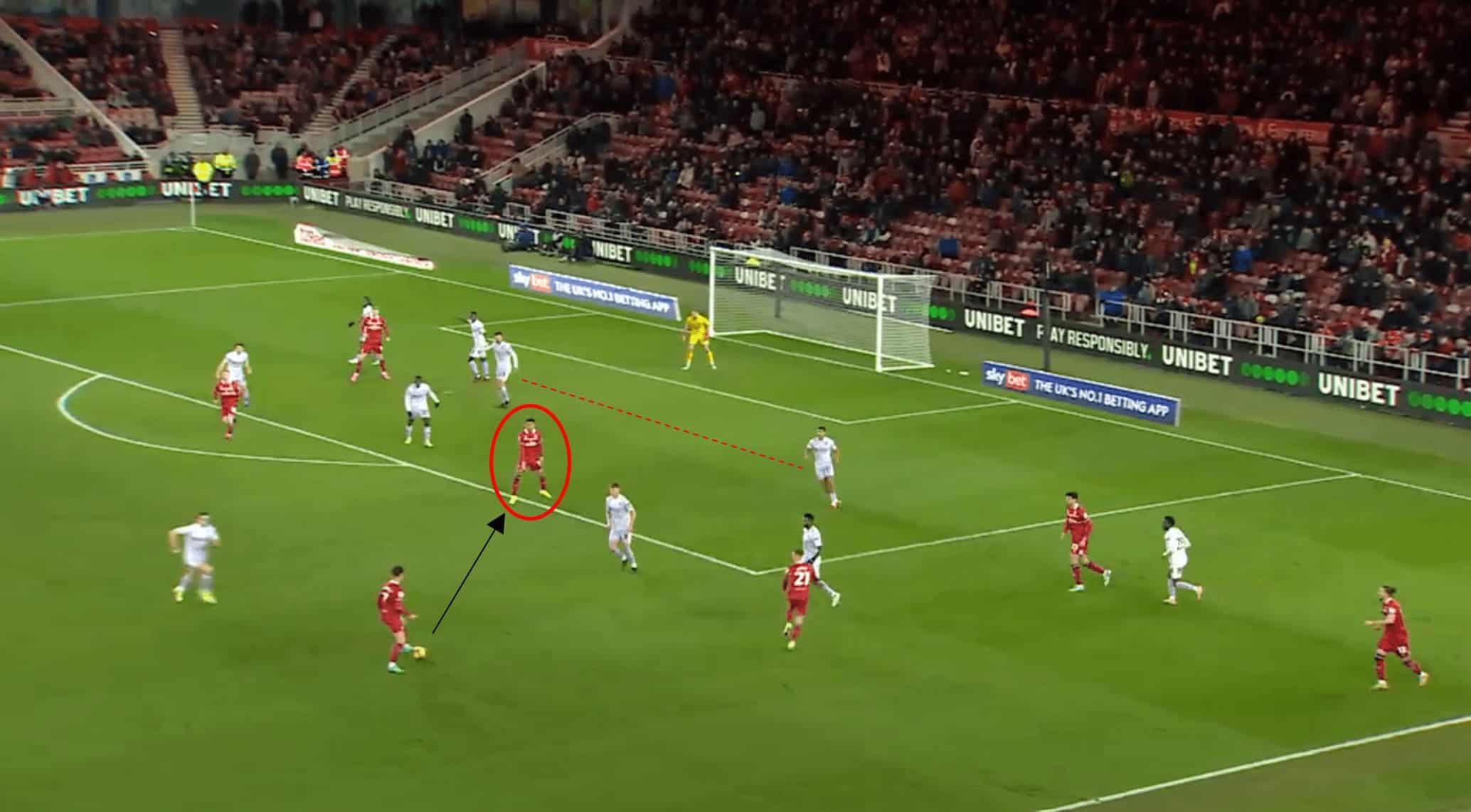
Prior to the incoming pass by Hayden Hackney, Rogers scanned the penalty area and was aware of the space in the opposition’s defensive line.
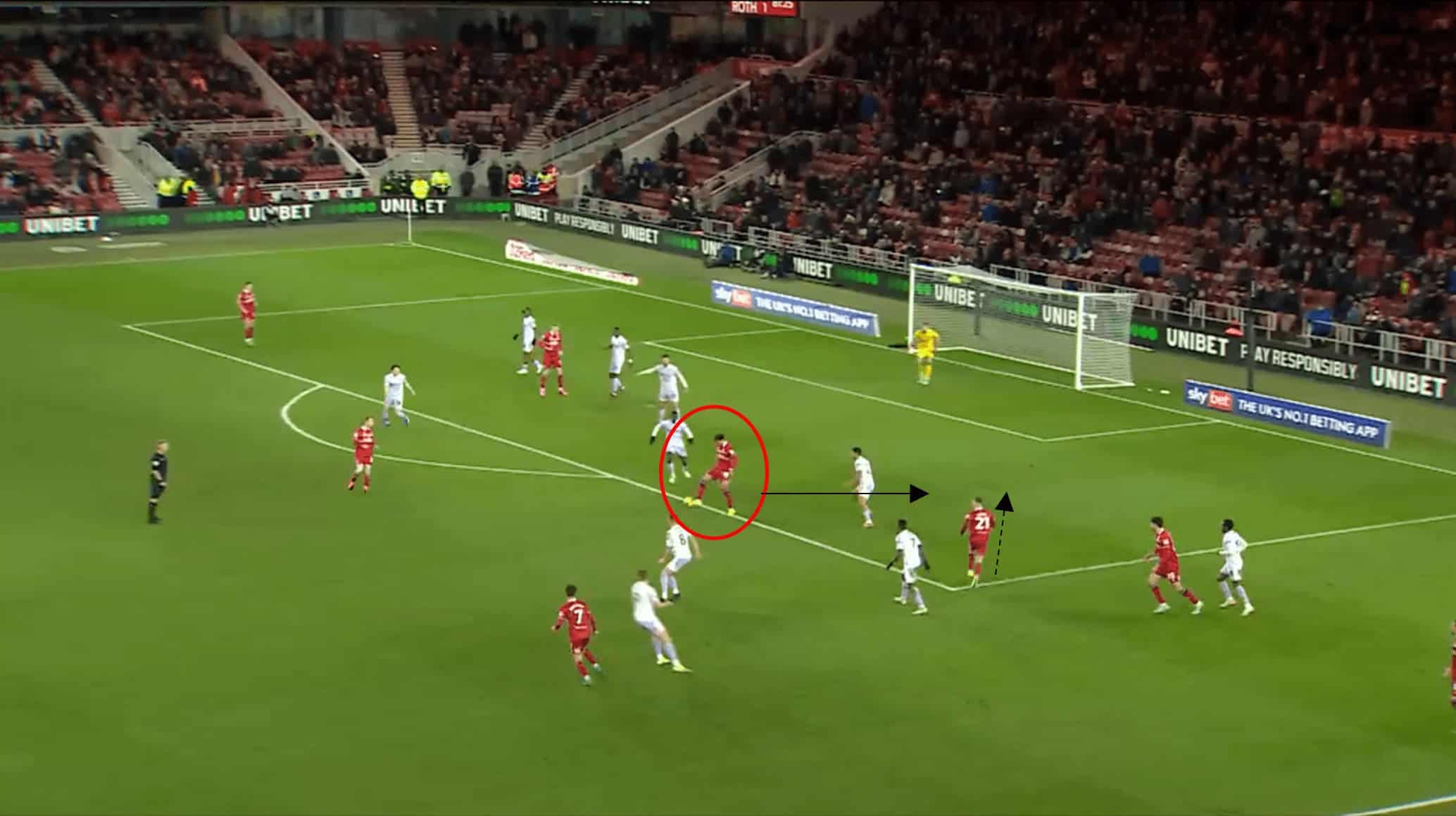
Once the pass had been made towards Rogers and with the opposition opting to close him down, his awareness of the space enabled him to play a clever flick towards the advancing Marcus Forss, who dispatched his effort on goal.
As the matches went by, Rogers was growing into his role on Teesside and finished as the top scorer in the League Cup as Boro made the semi-finals.
It was noticeable how the young midfielder was able to find pockets of space in and around the area and link up with others in the Boro forward line.
He was much less lightweight upfront and helped to advance play as Middlesbrough got their season back on track.
Rogers ranked in the top 8% compared to other attacking midfielders in England’s second tier for dangerous passes per 90, and this style of play caught the attention of Aston Villa, which paid an initial £8 million for his services.
Morgan Rogers Exceeding Expectations At Villa
Emery’s Villa side were the surprise package last campaign, with not many tipping them for a top-four finish, and it seemed a somewhat unusual choice for the Midlands side to opt to bolster their squad midway through the season with a Championship player.
Many will have anticipated that Rogers was outlined for a player to develop, but he soon found himself in the starting set-up.
Unlike his role at Boro, Rogers operates on the left side of Emery’s preferred 4-4-2 formation.
Under the Spaniard, Villa adopt a direct style of play in attack, and Rogers thrives in this system.
We have already demonstrated that Rogers has neat footwork, and these attributes have served him well at Villa Park.
His current side often works possession in tight areas, looking to combine with Ollie Watkins as the focal point upfront.
In Villa’s attacking principles, it is commonplace for the wider midfield to drive forward into the more central areas.
Morgan Rogers Ball Progression Map
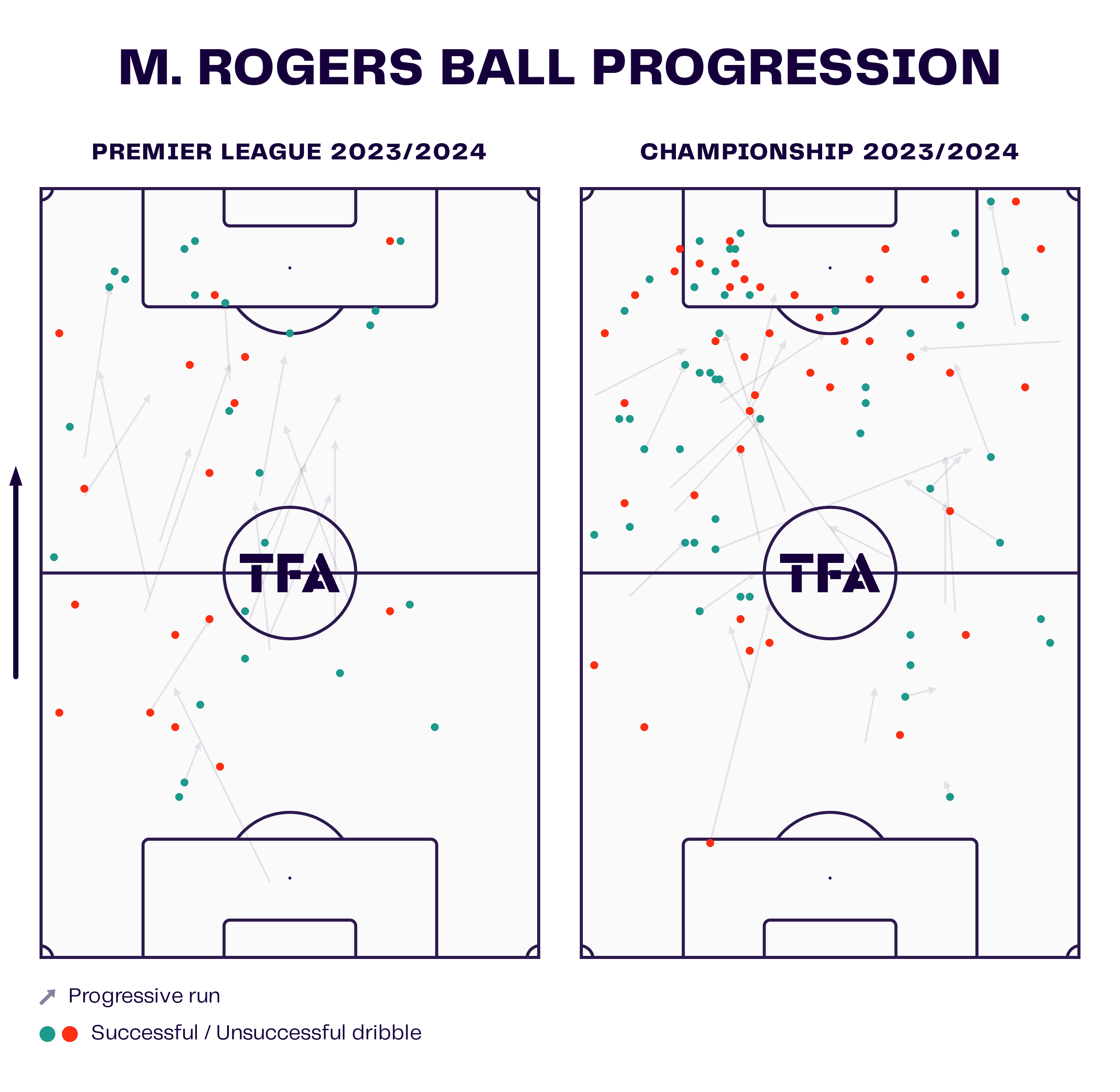
The above graphic shows that since his move to the Premier League, Rogers has been more positive in progressing the play, as he would often make more lateral runs in the Championship to find space in tight areas.
It is more the case now that upon receipt of possession, Rogers’ instinct is to accelerate forward.
The direct style suits Rogers, who is strong at receiving possession and advancing play on the turn.
Since his arrival at Villa Park, the midfielder has also been less wasteful in possession, as his miscontrols per 90 have decreased by 31%, and his dispossession rates per 90 have decreased by 38% compared to his time at Middlesbrough.
As Villa like to progress play quickly, their passing style can be to release Watkins down the channels or half-spaces, and a range of passing is required.
This is exemplified below, where Rogers has received possession and turned, before playing in the advancing Watkins.
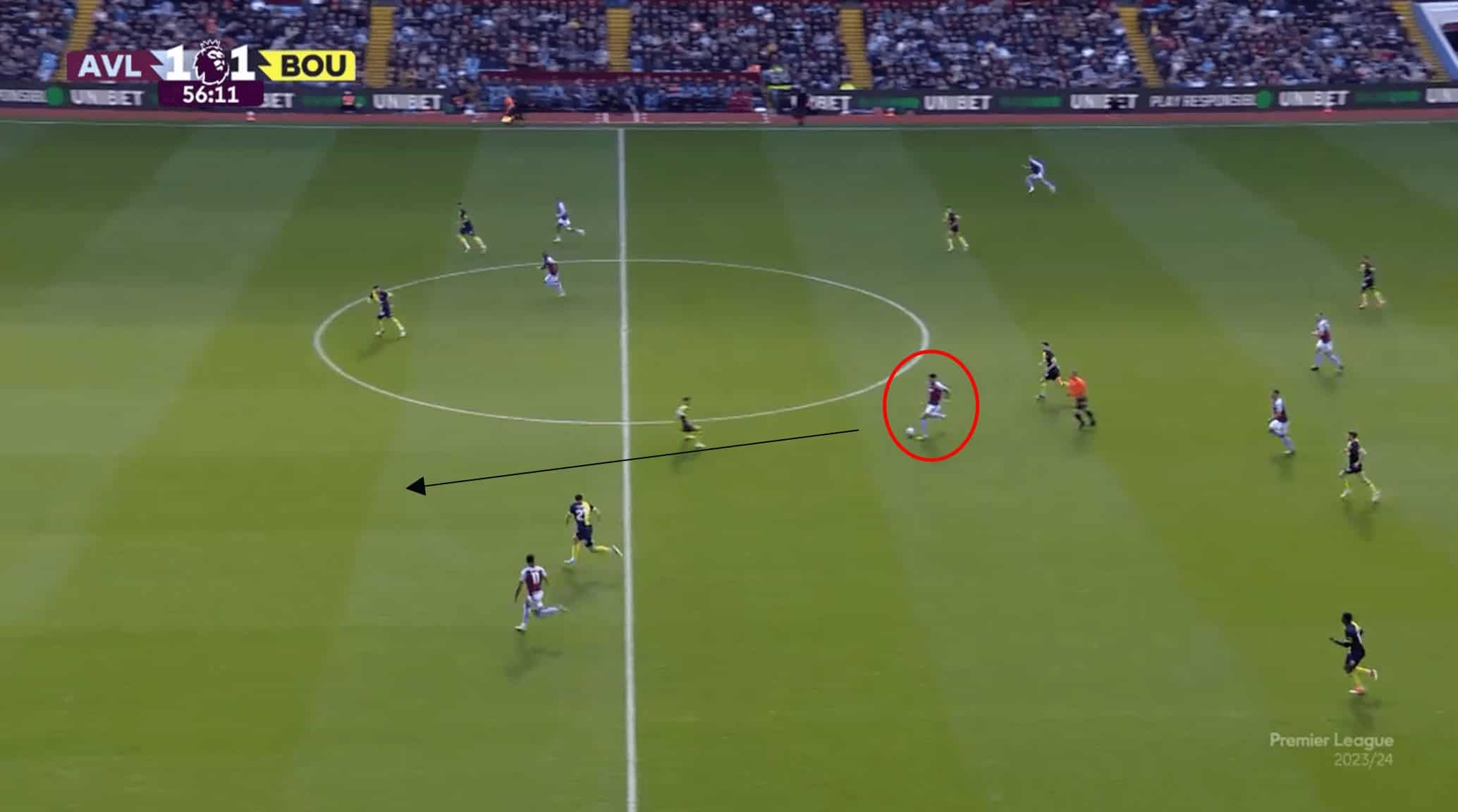
As a consequence of Villa’s variation in carrying the ball into the final third and quickly playing in the likes of Watkins, Rogers’ possessional play has improved.
Morgan Rogers Passing Statistics
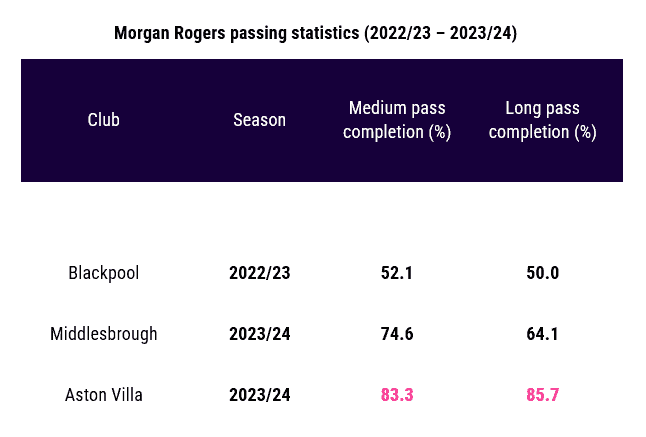
The table shows a marked improvement in Rogers’s passing range, particularly compared to his loan spell at Blackpool.
The statistics, therefore, showcase a player who is growing in confidence as he successfully completes more difficult passes.
As well as the improvements that Rogers has made on a personal level, he has also improved the balance of Emery’s side, who previously had been weaker in defence on the left side due to a lack of pace.
Rogers, though, has added such pace and has slotted into Villa’s system, with the Villans playing a high, aggressive defensive line, forcing the opposition out wide in a compact 4-4-2 shape out of possession.
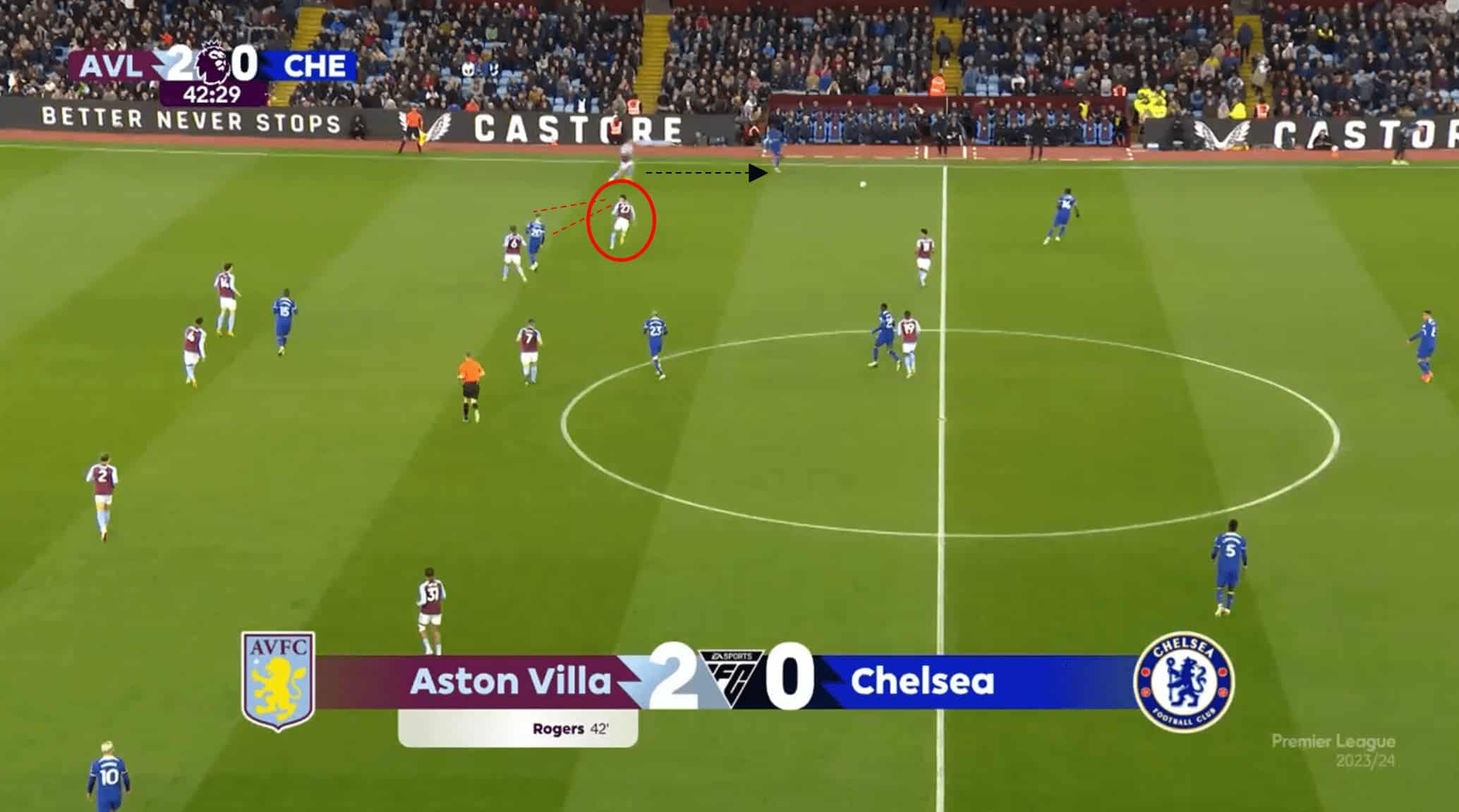
As Lucas Digne has closed down the opposition out wide, Rogers has checked the options Chelsea have in the forward line and ensured to provide cover for the more advanced Digne.
There are signs that Rogers is improving the tactical side of his game, as he is much more disciplined than in his earlier days at Boro.
That being said, there are certainly areas that Rogers could improve on.
Upon his transfer to Villa, he had only won 50% of defensive duels.
Moreover, he will be looking to improve his goal tally.
Rogers’ goals last season were often of high calibre, but it will be a case of whether he can improve this element of his game to find an end product on a more regular basis.
It will be encouraging to the Villa faithful, though, that Rogers has been much more clinical of late, with a goal-per-shot ratio of 0.27 compared to just 0.06 while on Teesside.
As Emery has often been dubbed a perfectionist in the past, he could well be the perfect manager to further develop Rogers’ promising talent.
Conclusion
The 2023/24 season has been potentially career-changing for Rogers, who, as this analysis has shown, improved tactically.
The greater understanding that Rogers has developed with teammates on the pitch has ensured his natural ability has not gone to waste.
While Rogers has developed physically, he has also become much more instinctive in driving play forward for his side.
Playing with a stronger crop of players will no doubt have aided his development, but this analysis has shown that for any young footballer, it is important to trust the process.
By no means is Rogers the finished article, but he is an example to young footballers that with the right attitude, there is always scope for development.






Comments